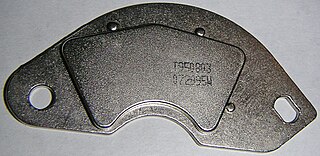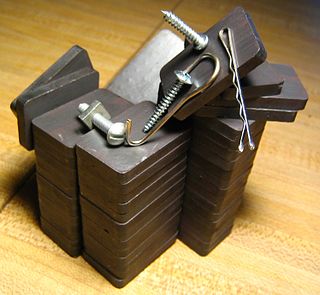
Ferromagnetism is the basic mechanism by which certain materials form permanent magnets, or are attracted to magnets. In physics, several different types of magnetism are distinguished. Ferromagnetism is the strongest type and is responsible for the common phenomenon of magnetism in magnets encountered in everyday life. Substances respond weakly to magnetic fields with three other types of magnetism—paramagnetism, diamagnetism, and antiferromagnetism—but the forces are usually so weak that they can be detected only by sensitive instruments in a laboratory. An everyday example of ferromagnetism is a refrigerator magnet used to hold notes on a refrigerator door. The attraction between a magnet and ferromagnetic material is "the quality of magnetism first apparent to the ancient world, and to us today".

A magnet is a material or object that produces a magnetic field. This magnetic field is invisible but is responsible for the most notable property of a magnet: a force that pulls on other ferromagnetic materials, such as iron, steel, nickel, cobalt, etc. and attracts or repels other magnets.
Remanence or remanent magnetization or residual magnetism is the magnetization left behind in a ferromagnetic material after an external magnetic field is removed. Colloquially, when a magnet is "magnetized" it has remanence. The remanence of magnetic materials provides the magnetic memory in magnetic storage devices, and is used as a source of information on the past Earth's magnetic field in paleomagnetism. The word remanence is from remanent + -ence, meaning "that which remains".

A neodymium magnet (also known as NdFeB, NIB or Neo magnet) is the most widely used type of rare-earth magnet. It is a permanent magnet made from an alloy of neodymium, iron, and boron to form the Nd2Fe14B tetragonal crystalline structure. Developed independently in 1984 by General Motors and Sumitomo Special Metals, neodymium magnets are the strongest type of permanent magnet available commercially.

A synchronous electric motor is an AC electric motor in which, at steady state, the rotation of the shaft is synchronized with the frequency of the supply current; the rotation period is exactly equal to an integral number of AC cycles. Synchronous motors contain multiphase AC electromagnets on the stator of the motor that create a magnetic field which rotates in time with the oscillations of the line current. The rotor with permanent magnets or electromagnets turns in step with the stator field at the same rate and as a result, provides the second synchronized rotating magnet field of any AC motor. A synchronous motor is termed doubly fed if it is supplied with independently excited multiphase AC electromagnets on both the rotor and stator.

Alnico is a family of iron alloys which in addition to iron are composed primarily of aluminium (Al), nickel (Ni), and cobalt (Co), hence the acronym al-ni-co. They also include copper, and sometimes titanium. Alnico alloys are ferromagnetic, and are used to make permanent magnets. Before the development of rare-earth magnets in the 1970s, they were the strongest type of permanent magnet. Other trade names for alloys in this family are: Alni, Alcomax, Hycomax, Columax, and Ticonal.
A magnetic core is a piece of magnetic material with a high magnetic permeability used to confine and guide magnetic fields in electrical, electromechanical and magnetic devices such as electromagnets, transformers, electric motors, generators, inductors, magnetic recording heads, and magnetic assemblies. It is made of ferromagnetic metal such as iron, or ferrimagnetic compounds such as ferrites. The high permeability, relative to the surrounding air, causes the magnetic field lines to be concentrated in the core material. The magnetic field is often created by a current-carrying coil of wire around the core.
A samarium–cobalt (SmCo) magnet, a type of rare-earth magnet, is a strong permanent magnet made of two basic elements samarium and cobalt.

Seen in some magnetic materials, saturation is the state reached when an increase in applied external magnetic field H cannot increase the magnetization of the material further, so the total magnetic flux density B more or less levels off. Saturation is a characteristic of ferromagnetic and ferrimagnetic materials, such as iron, nickel, cobalt and their alloys. Different ferromagnetic materials have different saturation levels.

Rare-earth magnets are strong permanent magnets made from alloys of rare-earth elements. Developed in the 1970s and 1980s, rare-earth magnets are the strongest type of permanent magnets made, producing significantly stronger magnetic fields than other types such as ferrite or alnico magnets. The magnetic field typically produced by rare-earth magnets can exceed 1.2 teslas, whereas ferrite or ceramic magnets typically exhibit fields of 0.5 to 1 tesla.

A ferrite is a ceramic material made by mixing and firing large proportions of iron(III) oxide (Fe2O3, rust) blended with small proportions of one or more additional metallic elements, such as strontium, barium, manganese, nickel, and zinc. They are ferrimagnetic, meaning they can be magnetized or attracted to a magnet. Unlike other ferromagnetic materials, most ferrites are not electrically conductive, making them useful in applications like magnetic cores for transformers to suppress eddy currents. Ferrites can be divided into two families based on their resistance to being demagnetized (magnetic coercivity).

Electrical steel is an iron alloy tailored to produce specific magnetic properties: small hysteresis area resulting in low power loss per cycle, low core loss, and high permeability.
Glass-coating is a process invented in 1924 by G. F. Taylor and converted into production machine by Ulitovski for producing fine glass-coated metal filaments only a few micrometres in diameter.

Permendur is a cobalt-iron soft ferromagnetic alloy with equal parts of cobalt and iron which is notable for its high magnetic saturation level. Its saturation flux density of around 2.4 tesla is the highest of any commercially available metal. Coupled with its low coercivity and core losses, its high saturation and permeability makes Permendur useful as magnetic cores in transformers, electric generators and other electrical equipment. The advantage of high saturation in a magnetic core is that it can function at higher magnetic field strengths, so the core can be smaller and lighter for a given magnetic flux and power level. Permendur is used for magnetic cores and pole pieces in lightweight transformers and electric motors used in aircraft. The alloy was invented in 1929 by Gustav Elmen at Bell Telephone Laboratories. Various formulations are sold under different trade names.
Electromagnetic brakes slow or stop motion using electromagnetic force to apply mechanical resistance (friction). They were originally called "electro-mechanical brakes," but over the years the name changed to "electromagnetic brakes", referring to their actuation method. Since becoming popular in the mid-20th century, especially in trains and trams, the variety of applications and brake designs has increased dramatically, but the basic operation remains the same.
Defence Metallurgical Research Laboratory (DMRL) is a research laboratory of the Defence Research and Development Organisation (DRDO). Located in Defence Research Complex, Kanchanbagh, Hyderabad. It is responsible for the development and manufacture of complex metals and materials required for modern warfare and weapon systems.

The Wiegand effect is a nonlinear magnetic effect, named after its discoverer John R. Wiegand, produced in specially annealed and hardened wire called Wiegand wire.
Bonded neo powder is produced by processing specific combination of elements that result in distinct magnetic and physical characteristics. These powders are the primary material used in the manufacture of bonded rare earth permanent magnets, which, in turn, are used in motors and sensors utilized in a wide variety of products for consumer and industrial end markets. Neodymium metal, one of the rare earth elements, is the primary raw material in neo powder. It is alloyed with iron and boron, occasionally along with other elements in small quantities. The alloy is melted and then rapidly solidified by melt spinning to produce neo powders with the desired characteristics for the manufacture of bonded neo magnets.

In magnetics, the maximum energy product is an important figure-of-merit for the strength of a permanent magnet material. It is often denoted (BH)max and is typically given in units of either kJ/m3 or MGOe. 1 MGOe is equivalent to 7.958 kJ/m3.









